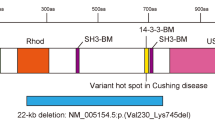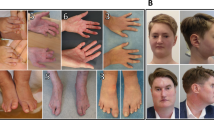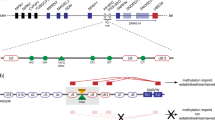Abstract
Angelman syndrome (AS) is associated with maternal deletions of human chromosome 15q11–q13 and with paternal uniparental disomy for this region indicating that deficiency of an imprinted, maternally expressed gene within the critical interval is the likely cause of the syndrome. Although the gene for E6-AP ubiquitin-protein ligase (UBE3A) was mapped to the critical region for AS, evidence of expression from both parental alleles initially suggested that it was an unlikely candidate gene for this disorder. Because attempts to identify any novel maternally expressed transcripts were unsuccessful and because the UBE3A gene remained within a narrowed AS critical region, we searched for mutations in UBE3A in 11 AS patients without known molecular defects (large deletion, uniparental disomy, or imprinting mutation). This analysis tested the possibility that deficiency of an undefined, maternally expressed transcript or isoform of the UBE3A gene could cause AS. Four mutations were identified including a de novo frameshift mutation and a de novo nonsense mutation in exon 3 and two missense mutations of less certain significance. The de novo truncating mutations indicate that UBE3A is the AS gene and suggest the possibility of a maternally expressed gene product in addition to the biallelically expressed transcript. Intragenic mutation of UBE3A in AS is the first example of a genetic disorder of the ubiquitin-dependent proteolytic pathway in mammals. It may represent an example of a human genetic disorder associated with a locus producing functionally distinct imprinted and biallelically expressed gene products.
This is a preview of subscription content, access via your institution
Access options
Subscribe to this journal
Receive 12 print issues and online access
$209.00 per year
only $17.42 per issue
Buy this article
- Purchase on Springer Link
- Instant access to full article PDF
Prices may be subject to local taxes which are calculated during checkout
Similar content being viewed by others
References
Nicholls, R.D. New insights reveal complex mechanisms involved in genomic imprinting. Am. J. Hum. Genet. 54, 733–740 (1994).
Ledbetter, D.H. & Ballabio, A. Molecular cytogenetics of contiguous gene syndromes: Mechanisms and consequences of gene dosage imbalance. in The Metabolic and Molecular Bases of Inherited Disease (eds Scriver, C. R., Beaudet, A.L,Sly, W.S. & Valle, D.)7thed. 811–839(McGraw-Hill, New York, 1995).
Özçelik, T. et al. Small nuclear ribonucleoprotein polypeptide N (SNRPN), an expressed gene in the Prader-Willi syndrome critical region. Nature Genet. 2, 265–269 (1992).
Leff, S.E. et al. Maternal imprinting of the mouse Snrpn gene and conserved linkage homology with the human Prader-Willi syndrome region. Nature Genet. 2, 259–264 (1992).
Glenn, C.C. et al. Modification of 15q11-q13 DNA methylation imprints in unique Angelman and Prader-Willi patients. Hum. Mol. Genet. 2, 1377–1382 (1993).
Sutcliffe, J.S. et al. Deletions of a differentially methylated CpG island at the SNRPN gene define a putative imprinting control region. Nature Genet. 8, 52–58 (1994).
Wevrick, R., Kerns, J.A. & Francke, U. Identification of a novel paternally expressed gene in the Prader-Willi syndrome region. Hum. Mol. Genet. 3, 1877–1882 (1994).
Buiting, K. et al. Inherited microdeletions in the Angelman and Prader-Willi syndromes define an imprinting centre on human chromosome 15. Nature Genet. 9, 395–400 (1995).
Nakao, M. et al. Imprinting analysis of three genes in the Prader-Willi/Angelman region: SNRPN, E6-associated protein, and PAR-2 (D15S225E). Hum. Mol. Genet. 3, 309–315 (1994).
Huibregtse, J.M., Scheffner, M. & Howley, P.M. Cloning and expression of the cDNA for E6-AP, a protein that mediates the interaction of the human papillomavirus E6 oncoprotein with p53. Mol. Cell Biol 13, 775–784 (1993).
Huibregtse, J.M., Scheffner, M. & Howley, P.M. A cellular protein mediates association of p53 with the E6 oncoprotein of human papillomavirus types 16 or 18. EMBO J. 10, 4129–4135 (1991).
Saitoh, S., Kubota, T., Ohta, T., Jinno, Y. & Niikawa, N., Angelman syndrome caused by imprinted submicroscopic deletion encompassing GABAA receptor 3-subunitgene. Lancet 339, 366–367 (1992).
Burke, L.W. et al. Familial cryptic translocation resulting in Angelman syndrome: Implications for imprinting or location of the Angelman gene? Am. J. Hum. Genet. 58, 777–784 (1996).
Woodage, T. et al. Physical mapping studies at D15S10: Implications for candidate gene identification in the Angelman syndrome/Prader-Willi syndrome chromosome region of 15q11-q13. Genomics 19, 170–172 (1994).
Williams, C.A. et al. Angelman syndrome: Consensus for diagnostic criteria. Am. J. Med. Genet. 56, 237–238 (1995).
Vu, T.H. & Hoffman, A.R. Promoter-specific imprinting of the human insulin-like growth factor-ll gene. Nature 371, 714–717 (1994).
DeChiara, T.M., Robertson, E.J. & Efstratiadis, A. Parental imprinting of the mouse insulin-like growth factor II gene. Cell 64, 849–859 (1991).
Meijers-Heijboer, E.J. et al. Linkage analysis with chromosome 15q11-13 markers shows genomic imprinting in familial Angelman syndrome. J. Med. Genet. 29, 853–857 (1992).
Wagstaff, J., Shugart, Y.Y. & Lalande, M. Linkage analysis in familial Angelman syndrome. Am. J. Hum. Genet. 53, 105–112 (1993).
Jentsch, S. The ubiquitin-conjugation system. Annu. Rev. Genet. 26, 179–207 (1992).
Ciechanover, A. The ubiquitin-proteasome proteolytic pathway. Cell 79, 13–21 (1994).
Scheffner, M., Nuber, U. & Huibregtse, J.M. Protein ubiquitination involving an E1-E2-E3 enzyme ubiquitin thioester cascade. Nature 373, 81–83 (1995).
Huibregtse, J.M., Scheffner, M., Beaudenon, S. & Howley, P.M. A family of proteins structurally and functionally related to the E6-AP ubiquitin-protein ligase. Proc. Natl. Acad. Sci. U.S.A. 92, 2563–2567 (1995).
Jentsch, S. & Schlenker, S. Selective protein degradation: a journey's end within the proteasome. Cell 82, 881–884 (1995).
Hochstrasser, M. Protein degradation or regulation: Ub the judge. Cell 84, 813–815 (1996).
Chen, Z.J., Parent, L. & Maniatis, T. Site-specific phosphorylation of IB by a novel ubiquitination-dependent protein kinase activity. Cell 84, 853–862 (1996).
Hicke, L. & Riezman, H. Ubiquitination of a yeast plasma membrane receptor signals its ligand-stimulated endocytosis. Cell 84, 277–287 (1996).
Matuschewski, K., Hauser, H.P., Treier, M. & Jentsch, S. Identification of a novel family of ubiquitin-conjugating enzymes with distinct amino-terminal extensions. J. Biol. Chem. 271, 2789–2794 (1996).
Oh, C.E., McMahon, R., Benzer, S. & Tanouye, M.A. bendless, a Drosophila gene affecting neuronal connectivity, encodes a ubiquitin-conjugating enzyme homolog j. Neurosci. 14, 3166–3179 (1994).
Author information
Authors and Affiliations
Corresponding author
Rights and permissions
About this article
Cite this article
Matsuura, T., Sutcliffe, J., Fang, P. et al. De novo truncating mutations in E6-AP ubiquitin-protein ligase gene (UBE3A) in Angelman syndrome. Nat Genet 15, 74–77 (1997). https://doi.org/10.1038/ng0197-74
Received:
Accepted:
Issue Date:
DOI: https://doi.org/10.1038/ng0197-74
This article is cited by
-
Relationship between strabismus associated with Angelman syndrome and orbital anomaly
Japanese Journal of Ophthalmology (2024)
-
Cortical and subcortical morphological alteration in Angelman syndrome
Journal of Neurodevelopmental Disorders (2023)
-
Linoleic acid improves PIEZO2 dysfunction in a mouse model of Angelman Syndrome
Nature Communications (2023)
-
Contextual fear memory impairment in Angelman syndrome model mice is associated with altered transcriptional responses
Scientific Reports (2023)
-
The contribution of imprinted genes to neurodevelopmental and neuropsychiatric disorders
Translational Psychiatry (2022)



